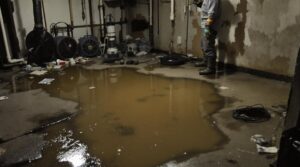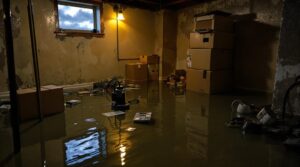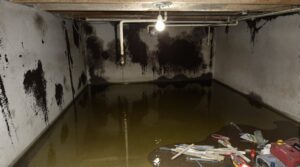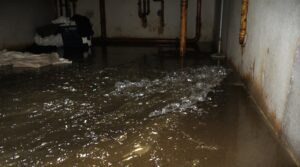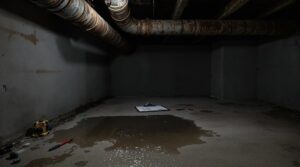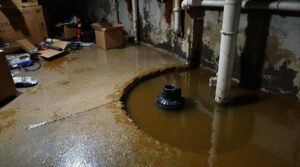Is your basement a ticking time bomb when it comes to flooding? Let's turn your underground space into an impenetrable fortress against water damage! Think of basement flood prevention like building a medieval castle's defense system – you need multiple layers of protection to keep the enemy (water) at bay.
Start with your first line of defense: proper drainage solutions. A French drain works like an underground superhighway for water, while a trusty sump pump acts as your basement's personal bodyguard, kicking out unwanted moisture before it becomes a problem. Your gutters and downspouts? They're the archers on your castle walls, directing water far from your foundation's vulnerable points.
Just like a doctor performing regular check-ups, scheduling structural inspections helps catch potential water entry points before they turn into full-blown problems. And here's a pro tip: create a natural water slide away from your home with a 6-inch grading slope – it's like giving water a gentle push in the right direction!
Welcome to the digital age of flood prevention! Modern water sensors and moisture mapping technology serve as your early warning system, like having a weather radar for your basement. By combining these old-school defenses with smart technology, you'll create an ironclad strategy that keeps your basement dry and your peace of mind intact.
Key Takeaways
Don't Let Your Basement Become an Indoor Pool! Essential Flood Prevention Tips
Your basement's worst enemy? Water. Let's tackle this moisture menace head-on with smart solutions that'll keep your lower level dry and protected.
Think of your sump pump as your basement's personal bodyguard – it's your first line of defense. Install a robust system with a battery backup (because storms and power outages love to party together). This guardian will automatically kick into action when water threatens to crash your basement's dry party.
Your yard should be like a gentle slide away from your house – create a 6-inch slope over 10 feet of distance. Water's lazy – it'll always take the path of least resistance, so make sure that path leads far from your foundation.
Those gutters? They're like your home's circulatory system. Keep them flowing freely and extend those downspouts at least 6 feet away from your walls. Think of clogged gutters as blocked arteries – they're just asking for trouble!
Found cracks in your foundation? Treat them like unwanted guests – show them the door! Seal them immediately and add a waterproofing system to your walls. It's like giving your basement a waterproof jacket.
Finally, embrace the power of proper drainage. French drains work like underground highways for water, while basement floor drains with P-traps act as your last line of defense. Together, they create an escape route for any water that dares to venture too close.
Understanding Common Causes of Basement Water Damage
Is your basement trying to tell you something about water damage? Let's dive into the world of basement flooding – a homeowner's headache that's better prevented than fixed!
Think of your basement as a fortress, constantly defending against three sneaky water invaders: outdoor troublemakers, structural weak spots, and rebellious mechanical systems.
Picture water as that uninvited guest who's always looking for a way in. Around your home's foundation, it's playing a game of "find the weakness," whether through poorly sloped yards or clogged drainage systems.
Just like a detective uses fingerprints, moisture mapping helps us track water's sneaky path around your foundation, revealing where it's putting the squeeze on your basement walls.
Your foundation's integrity is like armor – one crack or weak spot, and water finds its battle station. Those hairline cracks might seem innocent, but they're potentially VIP passes for unwanted moisture.
And let's not forget about your home's mechanical allies: sump pumps standing guard, gutters directing the flow, and plumbing systems that need to stay in fighting shape.
Want to stay one step ahead of water damage? Regular check-ups of your basement's defense system are your best bet. From inspecting downspouts to monitoring your sump pump's performance, treating these maintenance tasks like a home health check-up can save you from waking up to an unwanted indoor pool.
The statistics are sobering – water damage issues can decrease your property's value by 10-25%, making prevention absolutely crucial.
Essential Interior Waterproofing Solutions
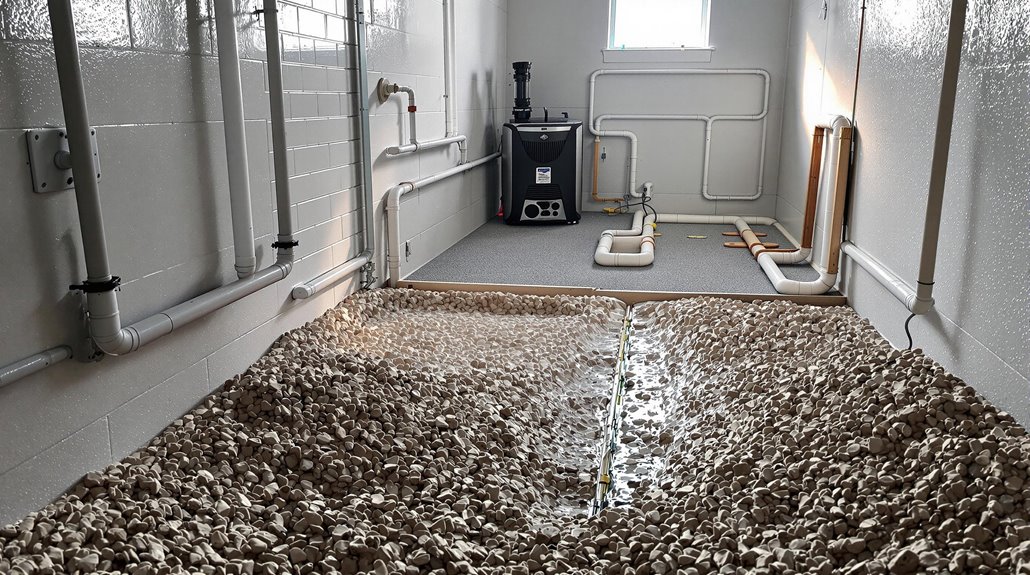
Is your basement playing hide and seek with water? Let's talk about turning your underground space into a fortress against moisture!
Think of interior waterproofing as your home's immune system – it needs multiple layers of defense to stay healthy.
At its core, you'll want a French drain system (think of it as your basement's personal moat) working hand-in-hand with a trusty sump pump to keep unwanted water at bay.
Ever heard of the WaterGuard system? It's like having invisible gutters inside your basement walls, cleverly channeling water away before it can crash your party.
But here's the thing – just like your car needs regular tune-ups, your drainage system craves attention too. Fresh gravel backfilling and system check-ups are your best friends in maintaining peak performance.
While vapor barriers and epoxy shots might seem like quick fixes (kind of like putting a Band-Aid on a leaky pipe), they're more of a temporary solution.
For real peace of mind, you'll want to invest in professional-grade sealants and advanced crack repair systems like FlexiSpan. These warriors work overtime to keep water where it belongs – outside!
Don't forget about your secret weapon – a quality dehumidifier.
Combined with regular structural check-ups, it's like having a 24/7 bodyguard for your basement. Want to know the best part? When all these elements work together, they create an impenetrable shield that keeps your basement dry and cozy for years to come.
With SANI-TRED liquid rubber and polymer mortars offering professional-grade protection, you can ensure complete waterproof coverage for your basement walls.
Smart Landscaping Strategies for Flood Prevention
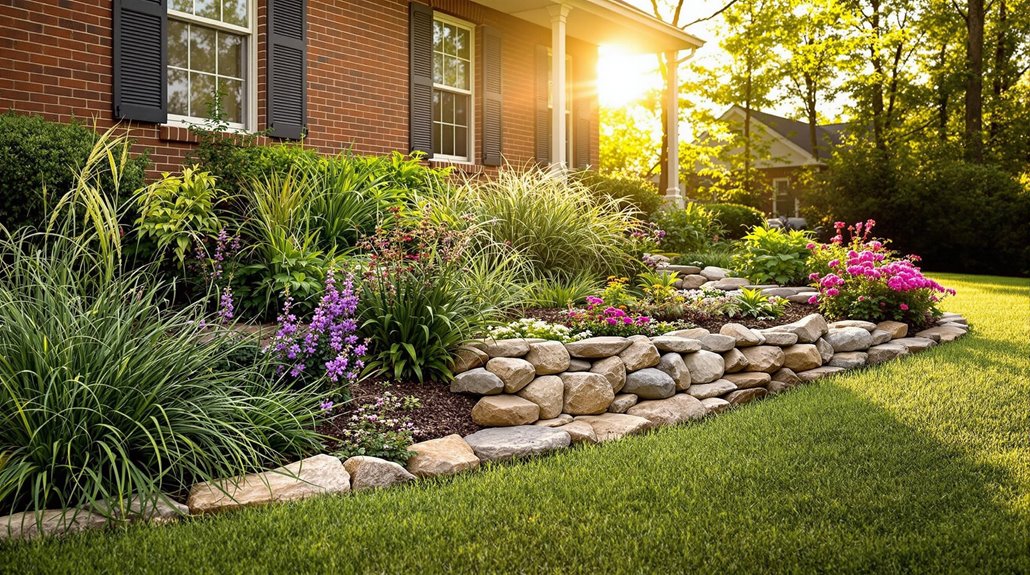
Want to turn your yard into a natural flood defender? Let's talk smart grading and planting strategies that work like a charm! Think of your landscape as nature's umbrella – when designed correctly, it shields your home from water damage.
Starting with the basics, your yard should gently slope away from your home's foundation, like a subtle waterslide. Aim for that magic number: a 6-inch drop for every 10 feet of horizontal space. This simple tilt becomes your first line of defense against unwanted water pooling.
But here's where it gets really interesting – native plants are your secret weapons! These local heroes pack deep, sturdy root systems that act like nature's own drainage network. They're literally built for your local climate and soil conditions, creating underground highways for water to travel through.
Why fight against nature when you can work with it? By combining proper grading with strategically placed native plants, you're essentially creating a living, breathing water management system.
These plants don't just look pretty – they're hard at work strengthening your soil and directing water exactly where it needs to go, keeping your foundation dry and your basement water-free.
Poor grading can significantly impact your foundation's stability and lead to expensive structural repairs.
Grading For Water Runoff
Want to keep your basement dry as a desert? Let's talk about smart grading – your home's natural defense system against unwanted water!
Think of grading as creating a gentle slope that guides rainwater away from your home, much like a mini water slide. The magic number? A slope between 2% to 5% away from your foundation. This isn't just a random figure – it's the sweet spot professional landscapers swear by for optimal drainage.
Getting the grade right is like conducting an orchestra – every element needs to work in harmony. Professional surveyors use high-tech tools like transit and laser levels to ensure precision, because even a slight miscalculation could send water in the wrong direction.
But here's where many homeowners stumble: it's not just about creating a slope. You'll need strategically placed swales (those shallow drainage channels) and berms (raised earth barriers) to choreograph water movement across your property.
Just remember – ditch the heavy machinery! Using bulky equipment can turn your soil into concrete, preventing natural water absorption.
How's your grading holding up? Regular check-ups are crucial, especially after heavy rains. Look for water pooling, erosion signs, or damp spots near your foundation. Think of it as giving your property's water management system an annual physical – catching issues early prevents costly basement floods later.
With only 27% of homeowners having flood insurance, proper grading becomes even more critical for protecting your investment.
Native Plants Enhance Drainage
Want to Turn Your Yard into a Natural Water-Managing Powerhouse? Native Plants Are Your Secret Weapon!
Think of native plants as nature's own plumbing system – they're like underground water superheroes working 24/7 to protect your basement from flooding. Their impressive root networks act as natural straws, slurping up excess water while strengthening your soil's structure.
Ready to level up your drainage game? Create a dream team by combining these water-wise warriors with smart landscaping features.
Picture this: a gorgeous rain garden where serviceberry shrubs thrive, or a bioswale where dogwood and witchhazel work their magic. These local champions don't just manage water – they're also filtering out pollutants and keeping your soil firmly in place during those heavy downpours.
But here's the real genius move: integrate your native plant strategy with permeable pavers and strategically placed rock channels.
Why does this matter? You'll not only solve water problems but also create a resilient, low-maintenance landscape that supports local wildlife. It's like building an eco-friendly fortress that looks stunning while doing all the heavy lifting for you!
Want to get started? Just remember the golden rule: work with your yard's natural slope and let these botanical experts do what they do best – turning potential water headaches into sustainable solutions.
Installing and Maintaining Effective Drainage Systems
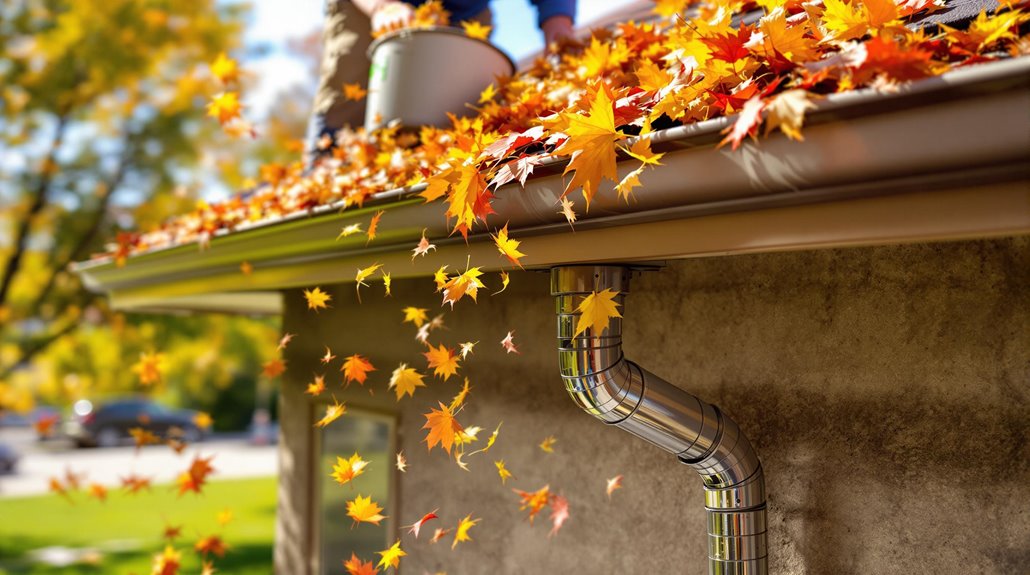
Ever wondered why your basement feels more like a swimming pool after heavy rain? Let's dive into the world of drainage systems – your home's secret superhero against water damage!
Think of your drainage system as a well-orchestrated water ballet. It starts with gutters, those unsung heroes perched along your roofline, catching raindrops and guiding them like skilled traffic controllers. Your downspouts then act as water slides, whisking the flow safely away from your foundation.
But that's just the beginning of the journey! Underground, a network of pipes and channels (imagine a mini-subway system for water) works tirelessly to escort unwanted moisture far from your home's perimeter.
The star player? The French drain – a clever combination of perforated pipes and gravel beds that's like a bouncer for groundwater.
Just like any superhero needs their maintenance, your drainage system craves regular TLC. Keep those gutters leaf-free, ensure your downspouts aren't playing hide-and-seek with their connections, and give your French drain an occasional spa day by clearing debris and checking its gravel bed. Trust me, your basement will thank you for it!
Inside your basement, a strategically placed basement floor drain with a P-trap mechanism provides crucial protection against sewer gases while maintaining proper water flow.
Proper Gutter System Installation
Want to Keep Your Basement Dry? Master the Art of Gutter Installation!
Think of gutters as your home's personal umbrella system – they're your first line of defense against water damage. Let's walk through a fail-proof installation that'll keep your basement as dry as a desert!
Before you climb that ladder, you'll need to play detective. Check your fascia boards for any sneaky rot or damage, and map out your downspout strategy like you're planning a military operation.
Here's the golden rule: your gutters need a gentle slope – just 1/4 inch per 10 feet – directing water toward those downspouts.
Ready to tackle the installation? Start by assembling your gutter sections on solid ground (trust me, it's way easier than doing acrobatics on a ladder).
Mount those brackets every 18-24 inches – think of them as your gutter's reliable support team.
The real magic happens at the connections. Your downspout adapters and joints need precision cuts and rock-solid sealing – imagine building a waterslide where every piece matters!
And here's the kicker: those downspouts should escort water at least ten feet away from your foundation, like a bouncer keeping trouble away from the club.
Consider scheduling annual professional inspections to ensure your gutter system maintains optimal performance and prevents costly water damage.
Underground Drainage Setup
Want to Keep Your Basement Dry? Master Your Underground Drainage Setup!
Think of underground drainage as your home's silent guardian – it's working 24/7 to keep water where it belongs: outside! Let's dive into how this unsung hero of home protection really works.
Your drainage journey starts with precision trenching – imagine carving out underground highways for water.
You'll need trenches that are generously sized: 300mm wider than your pipes, with specific widths of 410mm for 110mm pipes or 460mm for 160mm pipes. It's like creating a cozy tunnel that gives your pipes enough breathing room.
The secret sauce? It's all about the layers.
Start with a bed of pea shingle – think of it as a cushiony mattress for your pipes. Once your pipes are snug in their new home, more shingle goes on top for protection. It's like tucking your drainage system into a protective cocoon!
Key players in this underground network include:
- Underground hoppers (your water's first stop)
- Lowback P traps (the smell-blocking champions)
- Rodding eyes (your maintenance access heroes)
- Universal rainwater adaptors (the great water traffic controllers)
Remember those math lessons about angles? They're crucial here! Your pipes need just the right gradient to let gravity do its thing. Think of it as creating a water slide – too steep or too flat, and you've got problems.
Regular check-ups of your system's invert levels and falls are like giving your drainage a health screening. After all, wouldn't you rather catch small issues before they become basement floods?
According to experts, basement drain problems are responsible for 98% of all basement flooding incidents.
French Drain Maintenance Tips
Installing proper drainage systems is essential, since drain backups require costly professional remediation and pose serious health hazards.
Critical Foundation Protection Methods
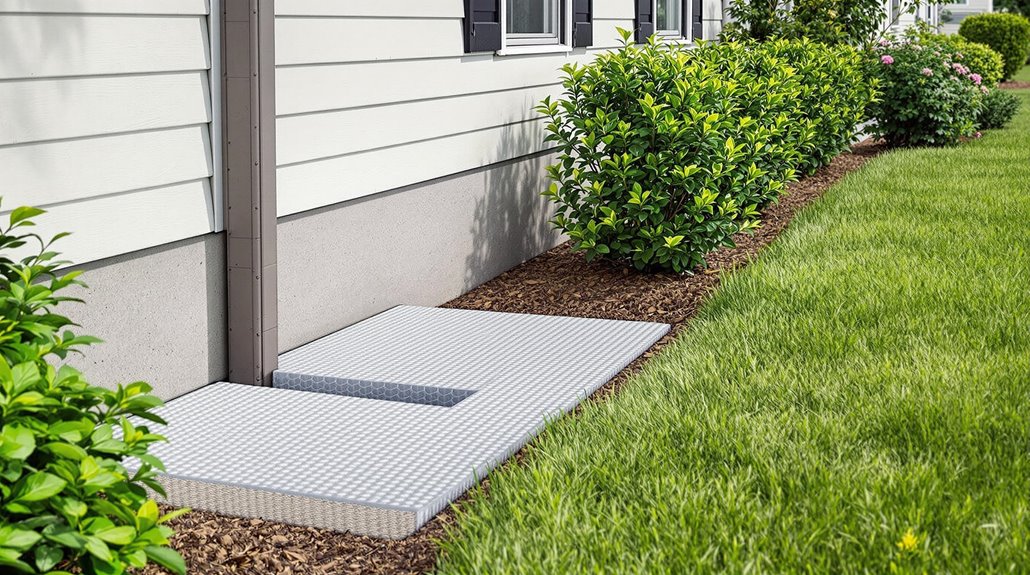
Want to Keep Your Foundation Dry as a Desert? Let's Talk Protection!
Think of your home's foundation as a shield – it needs the right armor to battle against water damage and flooding. You wouldn't go into a rainstorm without an umbrella, right? Well, your foundation needs even better protection!
Modern waterproofing systems, especially dimpled membranes (like our friend DELTA®-MS), work like tiny umbrellas creating air pockets that guide water away from your walls.
It's like giving your foundation its own personal drainage superhighway – way more effective than those old-school spray-on solutions, and they're pros at handling those pesky settlement cracks.
But here's the real secret sauce: you need a multi-layer defense strategy. Picture it as building a fortress:
- Start with smart exterior sealing using polymer coatings
- Add drainage systems that act like underground rivers
- Create a protective slope around your home (water should roll away, not toward your walls!)
- Keep your landscaping at least 6 inches away from foundation walls (plants need their personal space too!)
The key to success? Think like water. Where would it go? How can you redirect it?
Your best bet is combining free-draining backfill materials with below-grade drainage sheets – it's like creating a water-management master plan for your foundation.
Remember to check for cracks regularly and seal them promptly. After all, even the smallest crack can be like leaving your front door open during a storm!
A proper grading slope of 6-inches over 10 feet from your foundation is essential for effective water management.
Key Maintenance Tasks to Prevent Water Issues
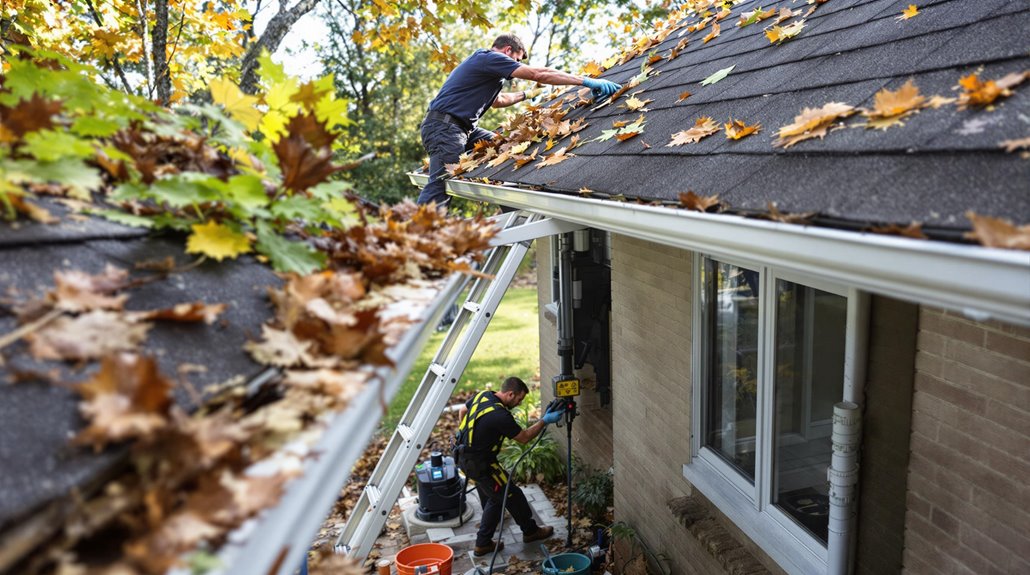
Think of your home as a fortress – and water as the sneaky invader trying to find its way in.
Just like a medieval castle needed multiple defense layers, your home requires a well-planned maintenance strategy to stay dry and protected.
Let's dive into the must-do tasks that'll keep water where it belongs – outside!
Your Water Defense Blueprint:
🌧️ Gutter Game Plan
- Treat your gutters like VIP bouncers – they need to be on point every season
- Get up there quarterly to clear leaves, twigs, and debris
- Make sure downspouts direct water at least 3 feet from your foundation (think of it as giving your house some personal space!)
💪 Sump Pump Success
- Your basement's superhero needs monthly check-ups
- Run a test cycle to ensure it's fighting fit
- Install a battery backup – because heroes need sidekicks when the power's out
🏡 Yard Drainage Detective Work
- Play landscape detective once a year
- Your yard should slope away from your house (imagine water sliding off a turtle's shell)
- If water's playing stubborn, French drains might be your secret weapon
🔧 Pro Plumbing Patrol
- Schedule yearly inspections with the experts
- Get those sewer lines cleaned (think of it as a spa day for your pipes)
- Test backwater valves – they're like one-way bouncers for your plumbing
Using a wet-dry vacuum regularly to remove debris from your basement floor drain can prevent gradual material accumulation and future clogs.
Remember: Each task builds another shield in your water defense arsenal. Stay consistent with these checks, and you'll spot potential troublemakers before they become full-blown water warriors!
Professional Waterproofing Options and Techniques

Want to keep water out of your home like a fortress keeps out invaders? Let's dive into professional waterproofing solutions that go beyond just patching up leaks!
Think of waterproofing as your home's raincoat – you can wear it inside or outside. Interior waterproofing is like setting up an umbrella inside your basement, catching water before it becomes a problem. It's usually friendlier to your wallet and won't turn your yard into a construction site.
Picture French drains working like underground rivers, channeling water to sump pumps that act as bouncers, showing unwanted moisture the exit.
But what about exterior solutions? They're like wrapping your foundation in a water-resistant shield. You've got options ranging from liquid synthetic membranes that paint on like sunscreen to clever bentonite sheets that actually expand when wet – nature's own seal of approval!
Installing these systems isn't a DIY weekend project, though. Interior work means breaking through concrete (imagine creating tiny underground tunnels) to install systems like WaterGuard.
Exterior jobs? They're more like archaeological digs around your foundation, requiring serious equipment and expertise.
Remember how your car needs regular check-ups? Your waterproofing system is no different. Keep those sump pumps humming and drains flowing freely, no matter which method you choose. Having professionals handle the installation isn't just a luxury – it's your insurance policy for a dry, healthy home that stands the test of time.
Smart leak detectors with conductivity sensors provide 24/7 monitoring of potential water intrusion points.
Did you know? The right waterproofing solution could save you thousands in potential water damage repairs while adding value to your property. Isn't it time to give your home the protection it deserves?
Emergency Prevention and Detection Systems
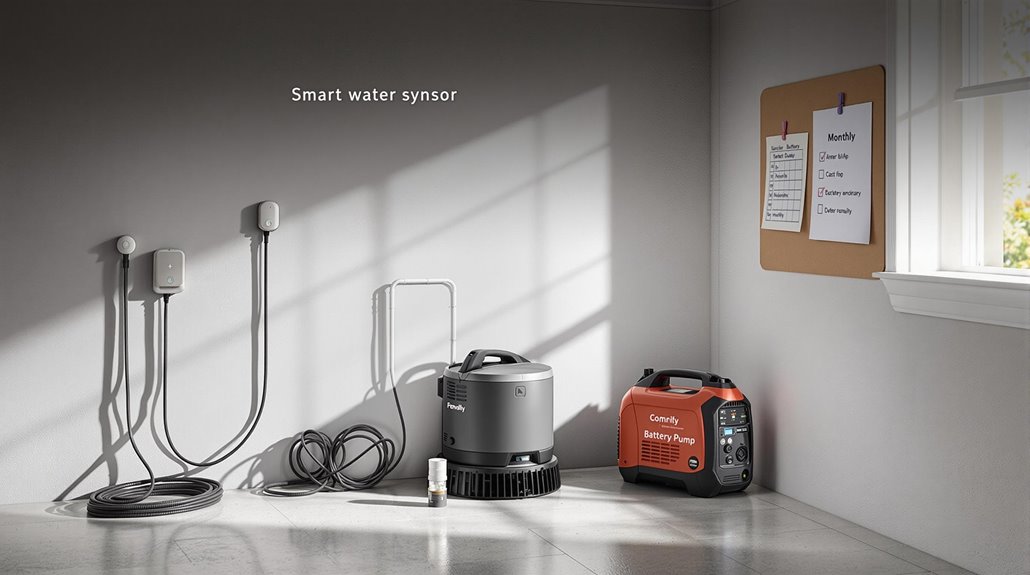
Worried About Basement Flooding? Here's Your Ultimate Emergency Prevention Guide!
Think of your basement as a fortress – you need reliable guards to protect it from unwanted water invasions. Modern emergency prevention and detection systems are like your personal flood-fighting army, working 24/7 to keep your basement dry and your peace of mind intact.
Let's talk about your basement's superhero squad:
Smart Water Sentinels
These clever devices act like vigilant watchdogs, instantly alerting you when water tries to sneak in. Connect them to your smartphone, and you'll get real-time updates wherever you are. No more coming home to unwelcome swimming pools in your basement!
Power Outage Warriors
Your primary sump pump needs a reliable sidekick – enter the battery backup pump. When storms knock out power (isn't that always when flooding happens?), these backup champions spring into action, ensuring continuous protection. Think of them as your insurance policy against Mother Nature's surprises.
Your Essential Defense Arsenal:
- Water sensors positioned at strategic entry points (like silent alarm systems)
- Smart home monitoring tech that puts control at your fingertips
- Backup power solutions (portable or standby generators)
- Battery-powered pumps ready for emergency duty
Pro Tip: Your protection system is only as good as its maintenance. Create a simple monthly checklist to:
✓ Test those battery levels
✓ Run a quick alarm check
✓ Give your pumps a practice run
✓ Inspect sensor placement
Just one inch of basement flooding can lead to up to $25,000 in property damage, making prevention systems a wise investment.
Cost-Effective DIY Waterproofing Measures
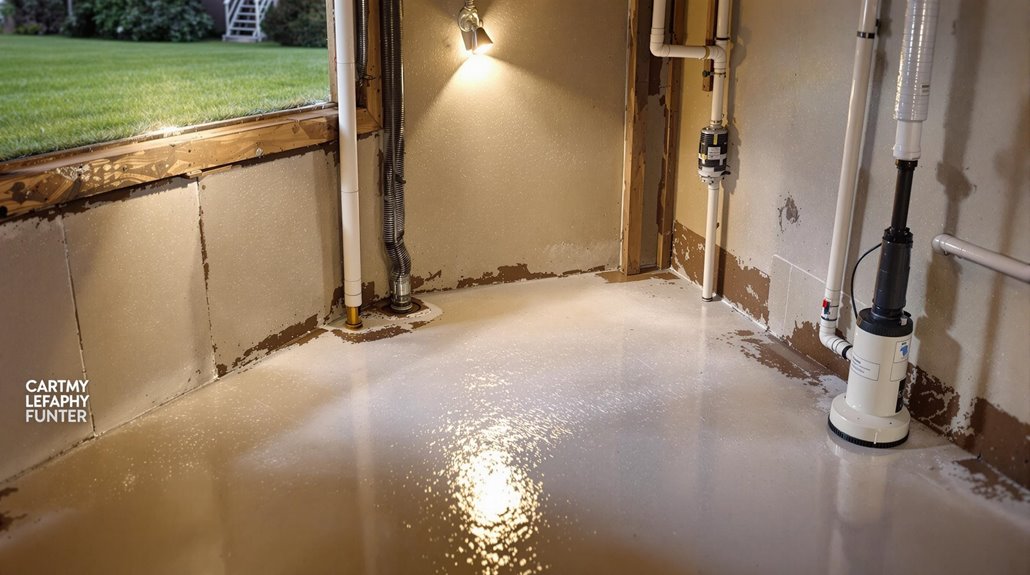
Ready to Transform Your Basement into a Dry Haven? DIY Waterproofing Made Simple!
Want to keep water out of your basement without breaking the bank? Let's dive into some wallet-friendly solutions you can tackle yourself! Think of waterproofing as giving your basement a protective shield – it's easier than you might imagine.
First up, let's talk about those pesky cracks. Just like applying a Band-Aid to a cut, you can treat foundation fissures with crack injections and sealants. Whether you choose epoxy (think super-strong glue) or polyurethane foam (imagine expanding insulation), these materials create a robust barrier against moisture sneaking through your walls and floors.
Looking for a more comprehensive solution? Picture creating a underground highway for water – that's exactly what an interior drainage system does!
By installing perforated pipes around your basement's perimeter connected to a sump pump, you're essentially giving unwanted water an express route out of your home.
But here's the real secret sauce: proper water management starts from the outside. Are your gutters functioning like well-organized traffic controllers, or are they more like rush hour chaos? Keep them clean and extend those downspouts!
And while you're at it, make your lawn work for you – grade it so water flows away from your foundation like a natural waterslide.
Pro tip: Consider a sump pump with a battery backup (think of it as your basement's emergency generator), and remember the six-inch rule – keep mulch away from your foundation walls to let your house breathe and drain properly. It's like giving your foundation personal space – everyone needs it, right?
For serious foundation issues, watch for doors not closing properly as this could indicate underlying structural problems requiring professional attention.
The Benefits Of Consulting A Public Adjuster
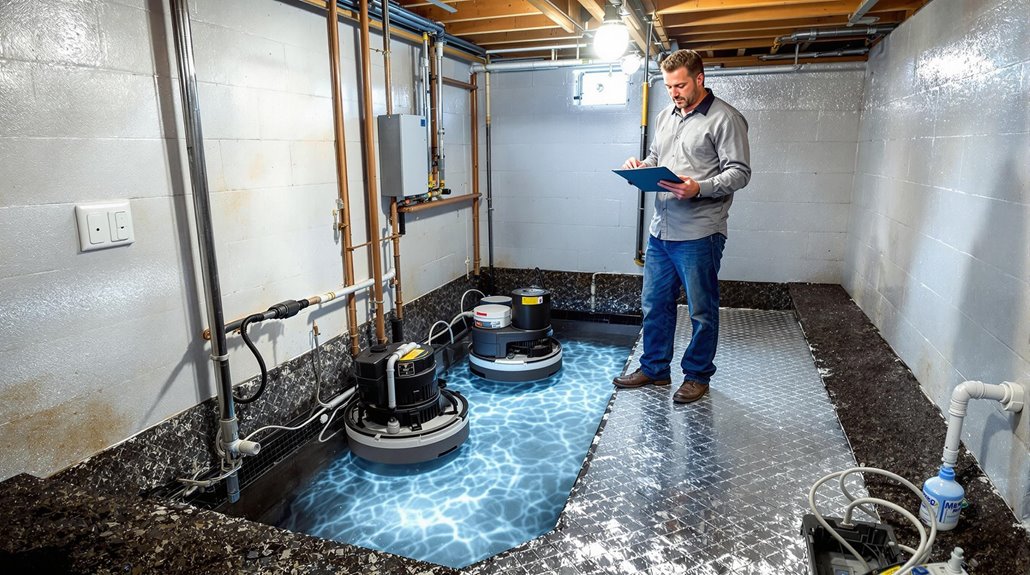
Ever felt overwhelmed dealing with insurance claims after water wreaks havoc in your basement? That's where public adjusters step in as your claims-savvy superheroes. Think of them as your personal insurance interpreters who speak the complex language of policies and coverage like native tongues.
Why should you consider partnering with a public adjuster? Well, they're like expert detectives who leave no stone unturned when assessing water damage.
They document everything with eagle-eyed precision – from that damaged drywall to your waterlogged belongings – building an airtight case for your claim.
But here's the real game-changer: research shows claims handled by public adjusters can boost your settlement by up to 747% compared to going solo. That's like turning a molehill payout into a mountain of proper compensation!
These professionals don't just file paperwork; they're skilled negotiators who go to bat for you against insurance companies.
They know all the industry tricks and terms, ensuring you don't settle for less than what your policy promises. Plus, they handle the headache-inducing paperwork while you focus on getting your life back to normal.
Ready to transform your insurance claim from a stressful maze into a straight path to fair compensation? A public adjuster might just be your ticket to peace of mind and proper payment.
Their fees typically range from 5 to 15 percent of your total insurance settlement, which often pays for itself through higher claim amounts.
Expertise In Insurance Claims
Dealing with a Flooded Basement? Here's Why Public Adjusters Are Your Secret Weapon
Ever felt like you're drowning in insurance paperwork after your basement floods? You're not alone!
Think of public adjusters as your personal insurance translators – they speak "insurance-ese" fluently and know exactly how to get you the settlement you deserve.
Why Your Flooded Basement Needs a Public Adjuster's Touch:
✓ They're like insurance detectives, spotting coverage details you might miss
✓ They document everything meticulously (imagine having a CSI team for water damage!)
✓ They're master negotiators who know insurance companies' playbooks
✓ They handle the paperwork avalanche while you focus on recovery
Smart Tip: While public adjusters typically receive 10% of your settlement, their expertise often pays for itself. Many homeowners see significantly higher payouts – sometimes 2-3 times more than handling claims solo!
Don't Just Take Our Word For It – Here's What They Bring to the Table:
- Water damage classification expertise
- Professional damage assessment tools
- Strategic claim presentation skills
- Real-time claim tracking
- Expert repair cost evaluation
Claims handled by public adjusters increase settlement amounts by up to 800% compared to self-managed claims.
Remember: Every hour counts with water damage! The sooner you get a public adjuster involved, the better your chances of maximizing your claim's value and preventing long-term issues.
Want to know if hiring a public adjuster is right for you? Most offer free initial consultations to evaluate your situation. It's like having an insurance GPS – they'll help navigate you to the best possible outcome!
Objective Damage Assessment
Has your basement turned into an unwanted indoor pool? Let's talk about why getting a professional damage assessment from a public adjuster could be your smartest first move.
Think of public adjusters as property damage detectives, armed with high-tech tools that would make CSI proud. They'll sweep through your space with thermal imaging cameras and moisture meters, uncovering water damage that's playing hide-and-seek behind walls and under floors.
But they don't just snap a few photos and call it a day. These claims experts create a comprehensive damage map of your basement – imagine it as a medical chart for your home.
They'll document everything from that obvious water line on your walls to sneaky moisture that could be plotting a future mold invasion.
Why does this matter? Because insurance companies might only see the tip of the iceberg.
Your public adjuster dives deeper, identifying not just what's damaged now, but what could become a bigger headache down the road. They'll build you a bulletproof claim that includes:
- Detailed visual evidence (photos and videos)
- Scientific moisture readings
- Future restoration needs
- Accurate cost projections
Think of it as building a watertight case for your water damage – one that ensures you don't get left high and dry when it comes to your insurance settlement.
Streamlined Claim Process
Wondering why basement flooding claims feel like navigating a maze? Let's talk about how public adjusters turn that maze into a straight path to settlement.
Think of public adjusters as your personal insurance GPS – they'll guide you through the claims journey with precision and expertise. When your basement turns into an unwanted indoor pool, these pros spring into action with a process that's smoother than a freshly dried floor.
🔍 Smart Documentation That Works
Public adjusters don't just take pictures – they create a digital fortress of evidence. Using cutting-edge tools, they capture every water-damaged detail, from soggy baseboards to waterlogged belongies, building your case like expert storytellers.
💬 Your Insurance Whisperer
Skip the frustrating back-and-forth with insurance companies. Your adjuster speaks their language fluently, translating complex policy jargon into real solutions. They're like having a skilled negotiator in your corner, fighting for every dollar you deserve.
⚖️ Playing by the Rules, Breaking Records
These claims ninjas know insurance regulations inside out. They'll ensure your claim hits every compliance checkpoint while dodging common pitfalls that could sink your settlement.
⚡ Fast Track to Resolution
Time is money (and mold prevention!) when your basement's underwater. Public adjusters fast-track your claim through tested strategies and iron-clad documentation, getting you back to normal life quicker than you'd expect.
Higher Claim Payouts & Settlements
Want to know why basement flooding claims often lead to bigger payouts? The secret weapon might be a public adjuster! Think of them as your personal claim champions who know exactly where to look for damage that might be playing hide and seek in your property.
Did you know that water damage isn't always obvious? Just like an iceberg, there's often more lurking beneath the surface. Public adjusters are like property damage detectives, armed with specialized tools and knowledge to uncover hidden moisture issues that could turn into costly problems down the road.
These insurance wizards speak "policy language" fluently and know all the industry tricks. They're essentially your insurance claim translators, turning complex policy jargon into plain English while fighting for every dollar you deserve.
When insurance companies try to lowball your claim, public adjusters counter with rock-solid evidence and expert negotiation skills.
They'll dive deep into the nitty-gritty details – from properly documenting water damage to calculating exact replacement costs. It's like having a financial guardian angel who ensures you don't leave money on the table.
They understand the crucial difference between actual cash value and replacement cost, helping you navigate these waters to secure the maximum settlement your policy allows.
About The Public Claims Adjusters Network (PCAN)
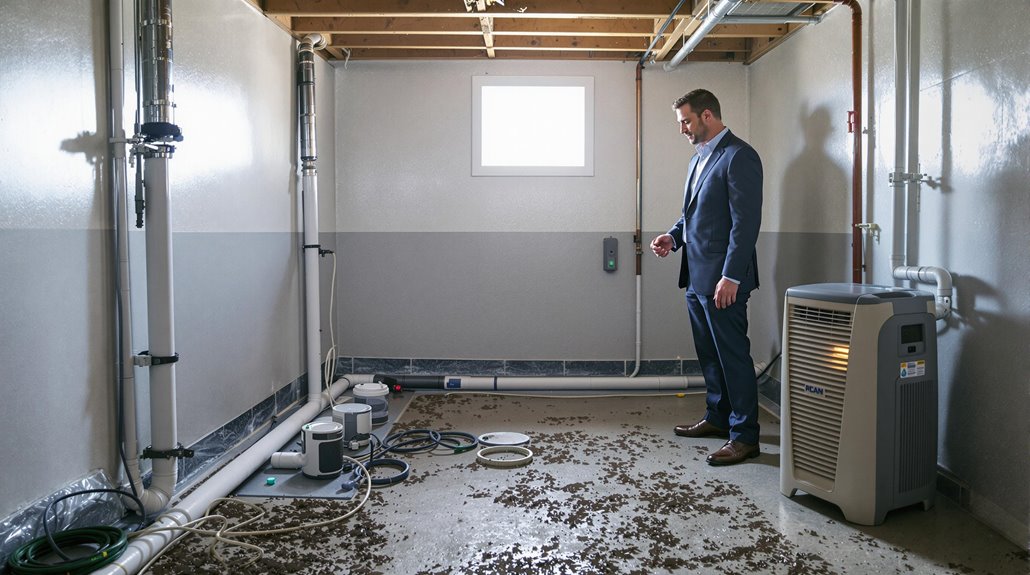
Meet Your Insurance Claim Champions: The PCAN Difference
Ever felt lost in the maze of insurance claims? That's where public claims adjusters step in – your dedicated advocates who've got your back when disaster strikes.
We're talking about seasoned professionals who speak "insurance-ese" fluently and fight for your rights like a protective big brother.
Think of PCAN members as your personal insurance detectives. They dig deep into policy details, document every scratch and dent, and build rock-solid cases for maximum compensation.
Unlike insurance company adjusters, these pros work exclusively for you – no divided loyalties, just pure policyholder advocacy.
What makes PCAN adjusters stand out?
✓ Lightning-fast response when you need it most
✓ Master negotiators who know every insurance policy inside-out
✓ Meticulous claim builders who leave no stone unturned
✓ State-licensed experts who play by the rules
Want to know the best part? These claim wizards work as a connected network, sharing insights and strategies to tackle even the trickiest cases.
It's like having a whole team of insurance superheroes in your corner, working to turn your claim from a headache into a victory.
Remember that leaky roof or storm damage that seemed impossible to prove? That's exactly where PCAN adjusters shine, transforming complex claims into clear-cut wins while you focus on getting your life back to normal.
They're not just adjusters; they're your peace-of-mind partners in the insurance jungle.
Frequently Asked Questions
How Long Does Professional Basement Waterproofing Typically Last Before Needing Replacement?
Ever wondered how long your basement waterproofing investment will keep those pesky water issues at bay? Think of professional waterproofing like a protective shield for your home's foundation – it's robust but not eternal.
Most professional waterproofing solutions stand strong for 10-20 years, much like a well-built car that needs proper care to go the distance. Your system's longevity depends on several key factors:
- Installation expertise (just like any craft, the installer's skill matters)
- Material quality (premium vs. standard solutions)
- Your local climate's mood swings
- Soil composition around your home
- Maintenance dedication (yes, it needs TLC too!)
Want to stretch your waterproofing's lifespan? High-end systems paired with regular check-ups can perform beautifully beyond the 20-year mark. It's like maintaining a prized garden – the more attention you give it, the longer it flourishes.
Remember to schedule periodic inspections and address minor issues before they become major headaches. Think of it as giving your basement's defense system a regular health check-up – prevention beats cure every time!
Can Basement Waterproofing Affect My Home's Resale Value?
Wondering if basement waterproofing is worth the investment? Let's dive into how it can transform your home's market value! Think of waterproofing as giving your basement a shield of armor – it not only protects your home's foundation but also sends a powerful message to potential buyers that you've taken excellent care of the property.
Research shows that a properly waterproofed basement can boost your home's resale value by up to 30%. But it's not just about the numbers. When buyers walk through your home, they're looking for red flags, and a dry, well-protected basement instantly checks off a major box on their wishlist. It's like having a five-star review for your home's foundation!
Smart buyers recognize that waterproofing is preventive maintenance that saves thousands in potential water damage repairs. Plus, it opens up possibilities for finished basement spaces – from home offices to entertainment rooms – making your property stand out in the competitive real estate market. Who wouldn't want a home that's ready for whatever Mother Nature throws at it?
What Insurance Policies Specifically Cover Basement Flooding Damage?
Wondering how to shield your basement from costly flood damage? Let's dive into the insurance coverage you really need!
Think of basement flood protection like a two-layer shield: your first line of defense is a standard homeowners policy with water backup coverage (that handy endorsement that tackles sewage and sump pump issues), while your second guardian is a separate National Flood Insurance Program (NFIP) policy.
The water backup endorsement typically offers $10,000 to $25,000 in protection – imagine that's your lifeline when that backed-up drain or failed sump pump wreaks havoc. But here's the kicker: without both types of coverage, you're essentially leaving your basement partially exposed to Mother Nature's whims.
Want comprehensive protection? Stack these policies together like puzzle pieces. Your basement's contents, from that cozy entertainment setup to your stored belongings, deserve nothing less than complete coverage against both internal water systems gone wrong and external flooding threats.
Remember: when it comes to basement flooding, it's not just about having insurance – it's about having the right combination of coverage to weather any storm.
Are Waterproofing Warranties Transferable to New Homeowners?
Wondering if your waterproofing warranty will stick around when you sell your home? Let's dive into what you need to know!
Think of waterproofing warranties like a protective umbrella – some stay with the house, while others pack up and leave with the original owner. The transferability largely depends on the warranty type you've got in your hands.
Standard lifetime warranties typically wave goodbye when you sell, much like a farewell party for the previous owner. However, transferable lifetime warranties are more like loyal house guardians – they stick with the property regardless of who holds the keys.
Limited and manufacturer's warranties? They're the flexible ones in the bunch. These can often make the jump to new owners, but there's usually some homework involved. You'll need to:
- Submit proper transfer documentation
- Meet specific timeline requirements
- Follow maintenance guidelines
- Pay any applicable transfer fees
Pro tip: Before buying a home with waterproofing work, always check the warranty's fine print and transfer conditions. It could save you from unexpected water woes down the road!
How Do Frozen Pipes Affect Basement Waterproofing Systems?
Think your pipe insulation investment is steep? Wait until you see the repair bill from frozen pipes wreaking havoc on your basement waterproofing system! When pipes freeze and burst, they're like ticking time bombs in your foundation, unleashing a cascade of problems that can turn your dry basement into an unwanted indoor pool. The real kicker? These frozen culprits don't just cause immediate flooding – they silently attack your foundation's structural integrity and can tear through waterproofing membranes like tissue paper. Just as you wouldn't leave your car unprotected in winter, your basement's pipes deserve the same attention to prevent a costly waterproofing catastrophe.
References
- https://utilitieskingston.com/Wastewater/basementflooding/protect
- https://ohiostatewaterproofing.com/3-basement-waterproofing-methods-and-their-advantages-and-disadvantages-lorain-oh/
- https://www.acurite.com/blogs/why-weather-matters/how-to-stop-basement-flooding
- https://www.progressive.com/lifelanes/basement-flooding-prevention/
- https://www.basementsystems.com/company/news-and-events/29001-the-3-major-approaches-to-basement-waterproofing.html
- https://www.servpro.com/resources/water-damage/basement_flooding_top_five_reasons
- https://firstcallnc.com/blog/prevent-common-causes-of-basement-flooding/
- https://www.nepowerdry.com/blog/the-10-most-common-causes-of-basement-flooding/
- https://www.puroclean.com/blog/causes-of-basement-flooding/
- https://luxcando.com/basement-waterproofing-methods/
